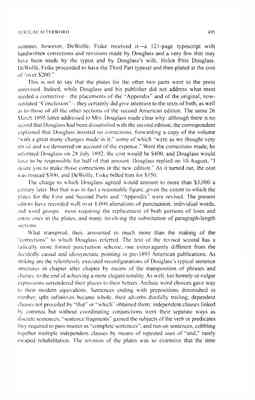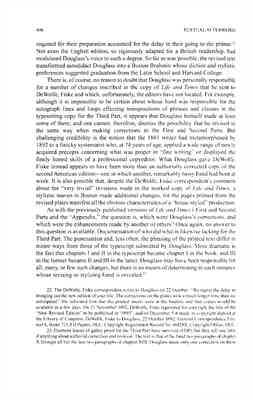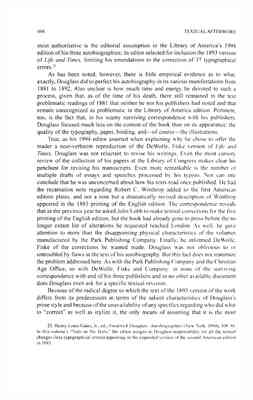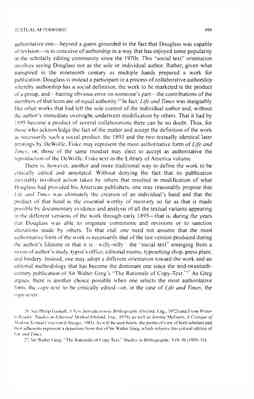Pages
11
TEXTUAL AFTERWORD
495
summer, however, DeWolfe, Fiske received it—a 121-page typescript with handwritten corrections and revisions made by Douglass and a very few that may have been made by the typist and by Douglass's wife, Helen Pitts Douglass. DeWolfe, Fiske proceeded to have the Third Part typeset and then plated at the cost of "over $200."
This is not to say that the plates for the other two parts went to the press unrevised. Indeed, while Douglass and his publisher did not address what most needed a corrective—the placements of the "Appendix" and of the original, nowoutdated "Conclusion"—they certainly did give attention to the texts of both, as well as to those of all the other sections of the second American edition. The same 26 March 1895 letter addressed to Mrs. Douglass made clear why: although there is no record that Douglass had been dissatisfied with the second edition, the correspondent explained that Douglass insisted on corrections, forwarding a copy of the volume "with a great many changes made in it," some of which "were as we thought very trivial and we demurred on account of the expense." Were the corrections made, he informed Douglass on 28 July 1892, the cost would be $400, and Douglass would have to be responsible for half of that amount. Douglass replied on 10 August, "I desire you to make those corrections in the new edition." As it turned out, the cost was instead $300, and DeWolfe, Fiske billed him for $150.
The charge to which Douglass agreed would amount to more than $3,000 a century later. But that was in fact a reasonable figure, given the extent to which the plates for the First and Second Parts and "Appendix" were revised. The present editors have recorded well over 1,000 alterations of punctuation, individual words, and word groups—most requiring the replacement of both portions of lines and entire ones in the plates, and many involving the substitution of paragraph-length sections.
What transpired, then, amounted to much more than the making of the "corrections" to which Douglass referred. The text of the revised second has a radically more formal punctuation scheme, one extravagantly different from the decidedly casual and idiosyncratic pointing in pre-1893 American publications. As striking are the relentlessly executed reconfigurations of Douglass's typical sentence structures in chapter after chapter by means of the transposition of phrases and clauses, to the end of achieving a more elegant tonality. As well, too homely or vulgar expressions surrendered their places to their betters. Archaic word choices gave way to their modern equivalents. Sentences ending with prepositions diminished in number; split infinitives became whole, their adverbs dutifully trailing; dependent clauses not preceded by "that" or "which" obtained them; independent clauses linked by commas but without coordinating conjunctions went their separate ways as discrete sentences; "sentence fragments" gained the subjects of the verb or predicates they required to pass muster as "complete sentences"; and run-on sentences, cobbling together multiple independent clauses by means of repeated uses of "and," rarely escaped rehabilitation. The revision of the plates was so extensive that the time
12
496
TEXTUAL AFTERWORD
required for their preparation accounted for the delay in their going to the printer.22 Not even the English edition, so rigorously adapted for a British readership, had modulated Douglass's voice to such a degree. So far as was possible, the revised text transformed autodidact Douglass into a Boston Brahmin whose diction and stylistic preferences suggested graduation from the Latin School and Harvard College.
There is, of course, no reason to doubt that Douglass was personally responsible for a number of changes inscribed in the copy of Life and Times that he sent to DeWolfe, Fiske and which, unfortunately, the editors have not located. For example, although it is impossible to be certain about whose hand was responsible for the autograph lines and loops effecting transpositions of phrases and clauses in the typesetting copy for the Third Part, it appears that Douglass himself made at least some of them; and one cannot, therefore, dismiss the possibility that he revised in the same way when making corrections in the First and Second Parts. But challenging credibility is the notion that the 1881 writer had metamorphosed by 1892 to a finicky systematist who, at 74 years of age, applied a wide range of newly acquired precepts concerning what was proper in "fine writing" or displayed the finely honed skills of a professional copyeditor. What Douglass gave DeWolfe, Fiske instead appears to have been more than an authorially corrected copy of the second American edition—one in which another, remarkably fussy hand had been at work. It is also possible that, despite the DeWolfe, Fiske correspondent's comment about the "very trivial" revisions made in the marked copy of Life and Times, a stylistic maven in Boston made additional changes; for the pages printed from the revised plates manifest all the obvious characteristics of a "house-styled" production.
As with the previously published versions of Life and Times's First and Second Parts and the "Appendix," the question is, which were Douglass's corrections, and which were the enhancements made by another or others? Once again, no answer to this question is available. Documentation of who did what is likewise lacking for the Third Part. The punctuation and, less often, the phrasing of the printed text differ in minor ways from those of the typescript submitted by Douglass. More dramatic is the fact that chapters I and II in the typescript became chapter I in the book, and III in the former became II and III in the latter. Douglass may have been responsible for all, many, or few such changes, but there is no means of determining in each instance whose revising or stylizing hand is revealed.23
22. The DeWolfe, Fiske correspondent wrote to Douglass on 22 October: "We regret the delay in bringing out the new edition of your life. The corrections on the plates took a much longer time than we anticipated." He informed him that the printed sheets were at the bindery and that copies would be made available in a few days. On 21 November 1892, DeWolfe, Fiske registered for copyright the title of the "New Revised Edition" to be published in "1893"; and on December 5 it made its copyright deposit at the Library of Congress. DeWolfe, Fiske to Douglass, 22 October 1892, General Correspondence File, reel 6, frame 715, FD Papers, DLC; Copyright Registration Record No. 46128X, Copyright Office, DLC.
23. Fourteen leaves of galley proof for the Third Part have survived (FDP), but they tell one little if anything about authorial correction and revision. The text is that of the final two paragraphs of chapter X through all but the last two paragraphs of chapter XIII. Douglass made only one correction on these
13
497
TEXTUAL AFTERWORD
Choice of Copy-Text
What Douglass thought of the DeWolfe, Fiske publication is a matter of record. He made it clear on 18 November 1892 that the advance copy sent him was a disappointment: "[I] am sorry to have to say that I have looked into it with less satisfaction than I had hoped. It is not such work as I had looked for from a Boston Publishing House." While the typography was up to par, the paper used was "inferior" and the binding "slovenly, imperfect and unattractive." That is, he was no more happy with its physical appearance than he had been when, a decade earlier, he complained to the Park Publishing Company about the shabbiness of the first American edition. As to the enhancements of his prose made in the second edition plates and like changes in the text of the Third Part, Douglass offered no commendation of a task well executed. He made no known comment at all, and one has good reason to wonder whether, once they were in print, he was even aware of the refinements of the text.24
There was, perhaps, another way in which Douglass withheld appreciation. The forgetfulness of a septuagenarian may be a legitimate explanation, but Douglass may instead have deliberately registered his discontent when he failed to live up to his financial agreement with DeWolfe, Fiske. His widow learned from the same 26 March 1895 letter from the publisher's correspondent that Douglass had gone to his grave without paying the $150 for the revision of the Park Publishing Company plates nor had he sent a check for 24 copies of the book he ordered.
Yet, the DeWolfe, Fiske Life and Times may today be assumed by many to be the most authoritative, or authorial, version of all—not only because it is the sole contemporaneous one that contains the Third Part, but because it is also the last published during the author's lifetime. The speculation regarding its authority would be that, since Douglass had over a decade in which to ensure that the first two parts read the way he intended, and he had two years in which to do the same with the third, surely his de facto "deathbed edition" was the one on which he had sedulously worked to perfect his testimony to a life well lived and worthy of trumpeting to the world. Surely it was he who again and again eliminated his decidedly vernacular word choices and otherwise toned up his sometimes too-homespun prose to make his book conform as much as possible to the expectations of the arbiters of belletristic taste in the 1890s. For example, that this form of the work is indeed the
leaves, changing "Minister" to "minister," the reading that appears in the published text. Whether Douglass actually returned this batch of proof to DeWolfe, Fiske is, however, moot. The need for the correction was self-evident, since "minister" used in the same way is the reading in the previous line and may very well have been recognized as an inconsistency and acted upon in Boston. That the chapters are misnumbered in galley proof and that Douglass did not make the corrections that appear in the published text is also noteworthy. Whether Douglass corrected and revised other batches of proof that he may have received cannot be determined.
24. Douglass to DeWolfe, Fiske and Company, November 18, 1892, General Correspondence File, reel 6, frames 735–36, FD Papers. DLC.
14
498
TEXTUAL AFTERWORD
most authoritative is the editorial assumption in the Library of America's 1994 edition of his three autobiographies; its editor selected for inclusion the 1893 version of Life and Times, limiting his emendations to the correction of 37 typographical errors.25
As has been noted, however, there is little empirical evidence as to what, exactly, Douglass did to perfect his autobiography in its various manifestations from 1881 to 1892. Also unclear is how much time and energy he devoted to such a process, given that, as of the time of his death, there still remained in the text problematic readings of 1881 that neither he nor his publishers had noted and that remain unrecognized as problematic in the Library of America edition. Pertinent, too, is the fact that, in his scanty surviving correspondence with his publishers, Douglass focused much less on the content of the book than on its appearance: the quality of the typography, paper, binding, and—of course—the illustrations.
True, as his 1994 editor asserted when explaining why he chose to offer the reader a near-verbatim reproduction of the DeWolfe, Fiske Version of Life and Times, Douglass was not reluctant to revise his writings. Even the most cursory review of the collection of his papers at the Library of Congress makes clear his penchant for revising his manuscripts. Even more remarkable is the number of multiple drafts of essays and speeches processed by his typists. Nor can one conclude that he was unconcerned about how his texts read once published. He had the recantation note regarding Robert C. Winthrop added to the first American edition plates, and not a note but a dramatically revised description of Winthrop appeared in the 1883 printing of the English edition. The correspondence reveals that in the previous year he asked John Lobb to make textual corrections for the first printing of the English edition, but the book had already gone to press before the no longer extant list of alterations he requested reached London. As well, he gave attention to more than the disappointing physical characteristics of the volumes manufactured by the Park Publishing Company. Finally, he informed DeWolfe, Fiske of the corrections he wanted made. Douglass was not oblivious to or untroubled by flaws in the text of his autobiography. But this fact does not minimize the problem addressed here. As with the Park Publishing Company and the Christian Age Office, so with DeWolfe, Fiske and Company: in none of the surviving correspondence with and of his three publishers and in no other available document does Douglass even ask for a specific textual revision.
Because of the radical degree to which the text of the 1893 version of the work differs from its predecessors in terms of the salient characteristics of Douglass's prose style and because of the unavailability of any specifics regarding who did what to "correct" as well as stylize it, the only means of assuming that it is the most
25. Henry Louis Gates, Jr., ed., Frederick Douglass: Autobigraphies (New York, 1994), 108–81. In this volume's "Note on the Texts," the editor assigns to Douglass responsibility for all the textual changes (less typographical errors) appearing in the expanded version of the second American edition in 1893.
15
TEXTUAL AFTERWORD
499
authoritative one—beyond a guess grounded in the fact that Douglass was capable of revision—is to conceive of authorship in a way that has enjoyed some popularity in the scholarly editing community since the 1970s. This "social text" orientation involves seeing Douglass not as the sole or individual author. Rather, given what transpired in the nineteenth century as multiple hands prepared a work for publication, Douglass is instead a participant in a process of collaborative authorship whereby authorship has a social definition, the work to be marketed is the product of a group, and—barring obvious error on someone's part—the contributions of the members of that team are of equal authority.26 In fact, Life and Times was inarguably like other works that had left the sole control of the individual author and, without the author's immediate oversight, underwent modification by others. That it had by 1895 become a product of several collaborations there can be no doubt. Thus, for those who acknowledge the fact of the matter and accept the definition of the work as necessarily such a social product, the 1893 and the two textually identical later printings by DeWolfe, Fiske may represent the most authoritative form of Life and Times; or, those of the same mindset may elect to accept as authoritative the reproduction of the DeWolfe, Fiske text in the Library of America volume.
There is, however, another and more traditional way to define the work to be critically edited and annotated. Without denying the fact that its publication inevitably involved action taken by others that resulted in modification of what Douglass had provided his American publishers, one may reasonably propose that Life and Times was ultimately the creation of an individual's hand and that the product of that hand is the essential worthy of recovery so far as that is made possible by documentary evidence and analysis of all the textual variants appearing in the different versions of the work through early 1895—that is, during the years that Douglass was able to originate corrections and revisions or to sanction alterations made by others. To that end, one need not assume that the most authoritative form of the work is necessarily that of the last version produced during the author's lifetime or that it is—willy-nilly—the "social text" emerging from a nexus of author's study, typist's office, editorial rooms, typesetting shop, press plant, and bindery. Instead, one may adopt a different orientation toward the work and an editorial methodology that has become the dominant one since the mid-twentiethcentury publication of Sir Walter Greg's "The Rationale of Copy-Text."27 As Greg argues, there is another choice possible when one selects the most authoritative form, the copy-text, to be critically edited—or, in the case of Life and Times, the copy-texts.
26. See Philip Gaskell, A New Introduction to Bibliography (Oxford, Eng., 1972) and From Writer to Reader: Studies in Editorial Method (Oxford, Eng., 1978), as well as Jerome McGann, A Critique of Modern Textual Criticism (Chicago, 1983). As will be seen below, the points of view of both scholars and their adherents represent a departure from that of Sir Walter Greg, which informs this critical edition of Life and Times.
27. Sir Walter Greg, "The Rationale of Copy-Text," Studies in Bibliography, 3:19–36 (1950–51).




